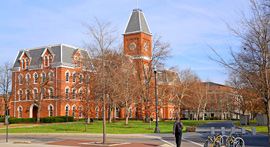Academics
Notre Dame has many traditions, including a “devotion to undergraduate education” you might not expect from a school with such an athletic reputation. Professors here are, by all accounts, “wonderful”: “Not only are they invested in their students,” they’re “genuinely passionate about their fields of study,” “enthusiastic and animated in lectures,” and “always willing to meet outside of class to give extra help.” Wary that distance might breed academic disengagement, professors ensure “large lectures are broken down into smaller discussion groups once a week to help with class material and…give the class a personal touch.” For its part, “the administration tries its best to stay on top of the students’ wants and needs.” They make it “extremely easy to get in touch with anyone.” Like the professors, administrators try to make personal connections with students. For example, “our president (a priest), as well as both of our presidents emeritus, make it a point to interact with the students in a variety of ways—teaching a class, saying mass in the dorms, etc.” Overall, “while classes are difficult,” “students are competitive against one another,” and “it’s necessary to study hard and often, there’s also time to do other things.”
Student Body
Undergrads at Notre Dame report “the vast majority” of their peers are “very smart” “white kids from upperto middle-class backgrounds from all over the country, especially the Midwest and Northeast.” The typical student “is a type-A personality that studies a lot, yet is athletic and involved in the community. They are usually the outstanding seniors in their high schools,” the “sort of people who can talk about the BCS rankings and Derrida in the same breath.” Additionally, something like “85 percent of Notre Dame students earned a varsity letter in high school.” Students note that many, but not all, students are Catholic, but overall, undergrads seem to “have some sort of spirituality present in their daily lives.” So far as diversity goes, ND is reported to be improving when it comes to “economic backgrounds, with the university’s policy to meet all demonstrate financial need.” And while students are working to help everyone fit in, they note that those who don’t still “hang out in their own groups.”
Campus Life
Life at Notre Dame is centered around two things—“residential life” and “sports.” The “dorms on campus provide the social structure” and supply undergrads with tons of opportunities to get involved and have fun. “During the school week,” students “study a lot, but on the weekends everyone seems to make up for the lack of partying during the week.” The school “does not have any fraternities or sororities, but campus is not dry, and drinking/partying is permitted within the residence halls.” The administration reportedly tries “to keep the parties on campus due to the fact that campus is such a safe place and they truly do care about our safety.” In addition to parties the dorms are really competitive in the Interhall Sport System, and “virtually every student plays some kind of sport [in] his/her residence hall.” Intercollegiate sports, “are huge” (to put it mildly): “If someone is not interested in sports upon arrival, he or she will be by the time he or she leaves.” To put it another way, “Everybody goes to the football games, and it’s common to see 1,000 students at a home soccer game.” Beyond residential life and sports, “religious activities,” volunteering, “campus publications, student government, and academic clubs round out the rest of ND life.”




